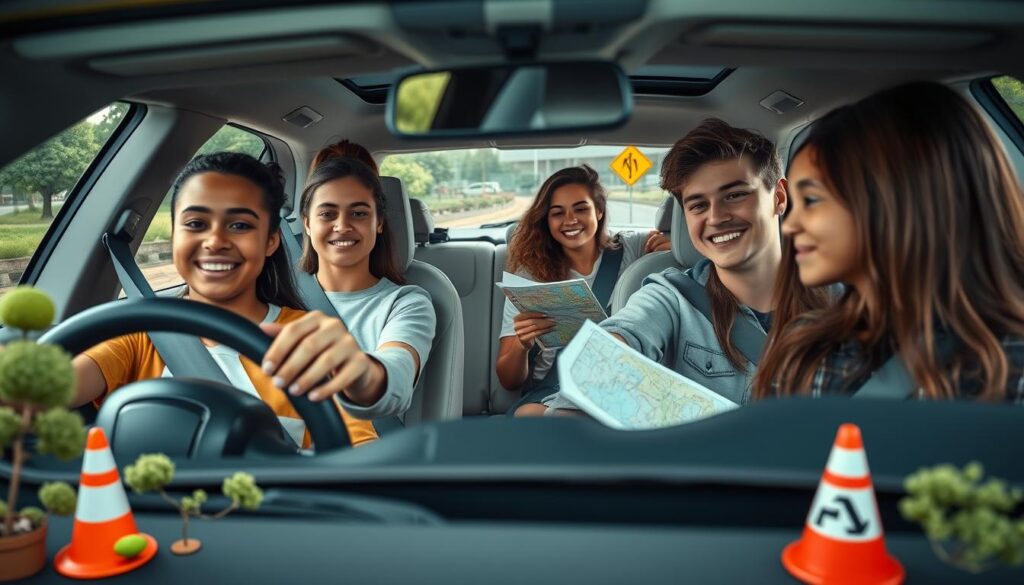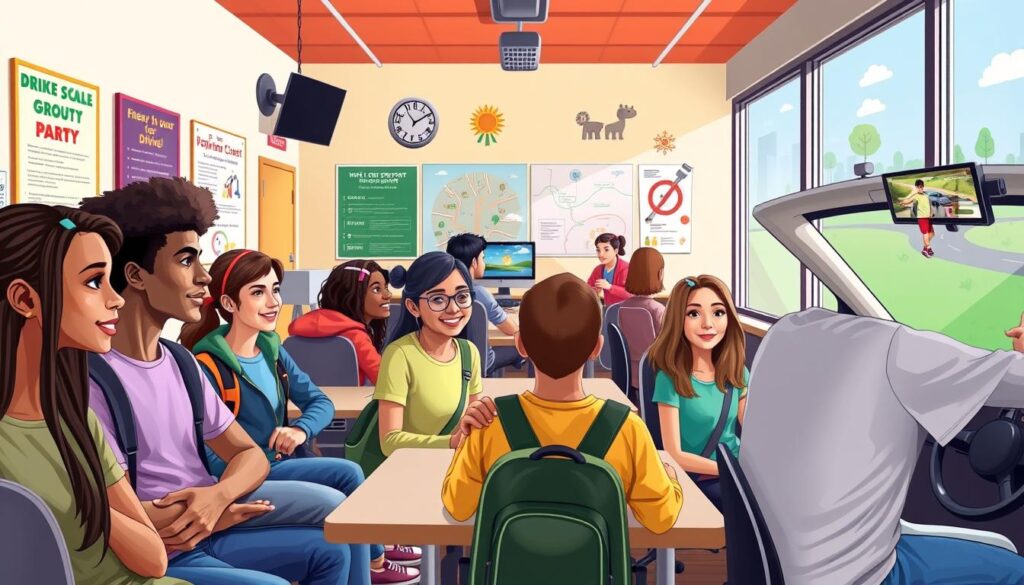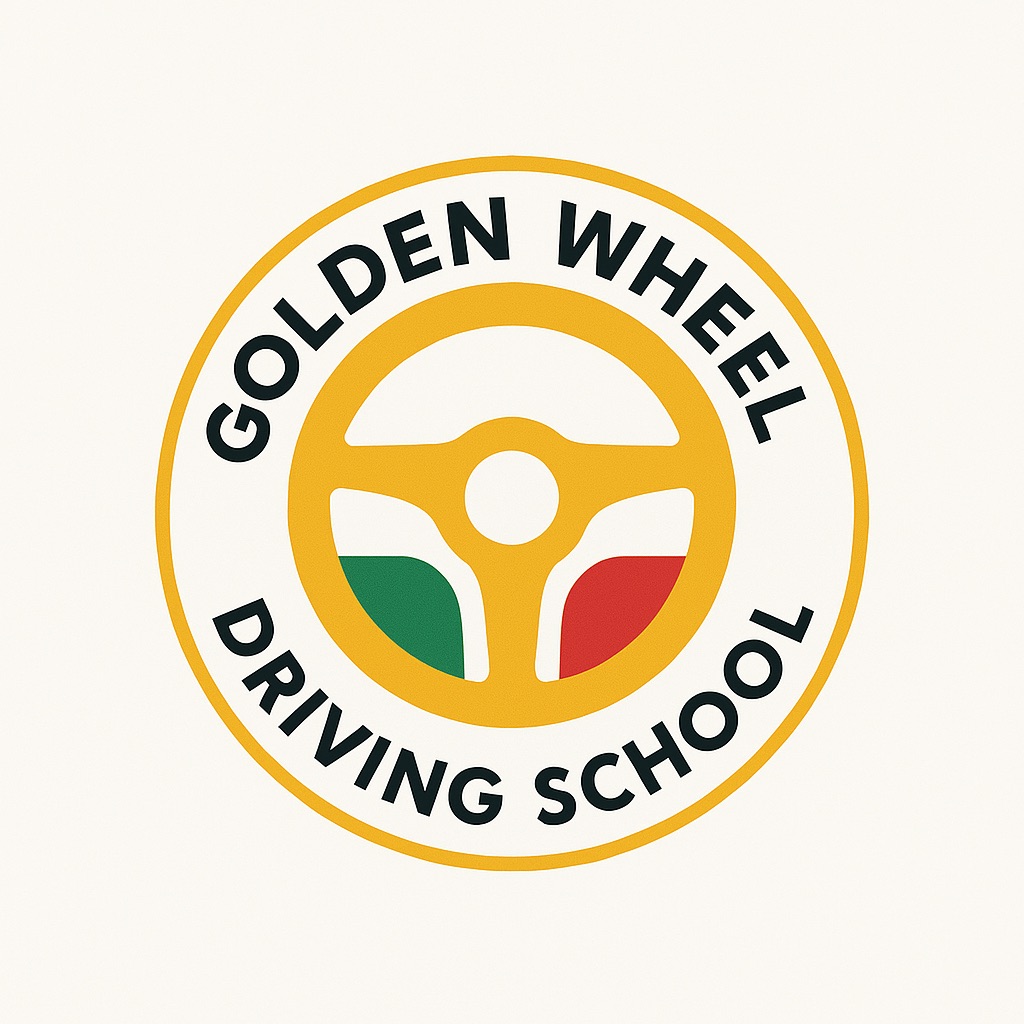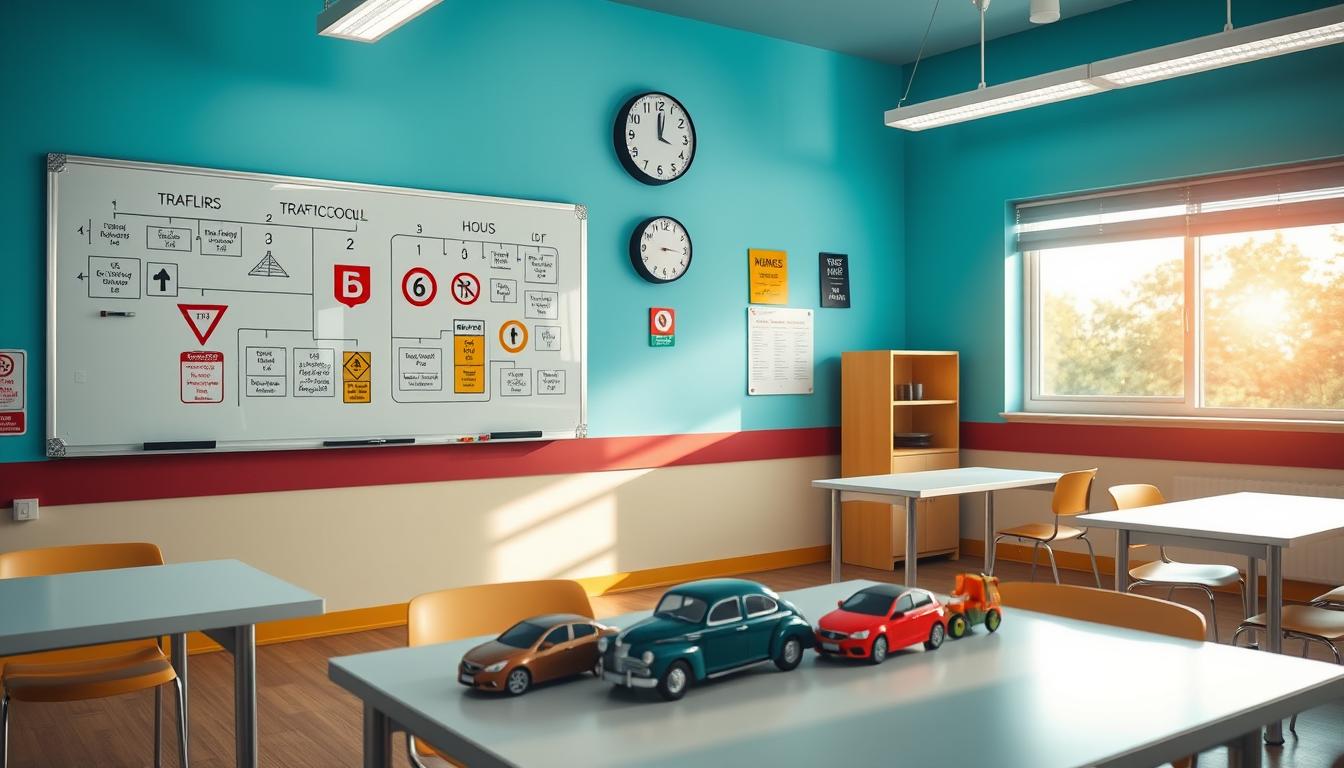Learning to drive is exciting for teens. Six hour programs are a great start. They teach teens the skills to drive safely and responsibly. With expert instructors and a solid plan, teens can drive with confidence.
For more information, please call 973-310-7744. Our six hour programs for teens are made for young drivers. They offer a full learning experience, covering all driving aspects.
Introduction to Six Hour Programs
We aim to equip teens with the skills for safe driving. Our six hour programs help young drivers reach their goals. They become confident and skilled behind the wheel.
Key Takeaways
- Six hour programs for teens are designed to teach essential driving skills and knowledge
- Professional instructors provide guidance and support throughout the program
- A well-structured curriculum ensures a comprehensive learning experience
- Teens can learn how to navigate the roads with confidence in a teen program
- Our programs are tailored to meet the needs of young drivers
- For more information, please call 973-310-7744
Understanding Six Hour Programs for Teens: The Basics
Teens starting their driver’s license journey need to know about six-hour driving programs. These programs are key for teen development. They mix classroom learning with driving practice. This helps teens learn safe driving and road behavior.
Programs vary by provider but usually include several lessons. Topics include road safety, traffic laws, and car upkeep. Here’s what you need to know:
- Classroom instruction: This part teaches driving theory, like road signs and traffic laws.
- Behind-the-wheel training: Teens get to practice driving with a certified instructor.
- Program evaluation: This checks how well teens understand the material and offers feedback.
Knowing about six-hour driving programs helps teens choose their driving education. These programs support teen development. They also encourage youth activities that build community and responsibility.
The Important Role of Professional Driving Education
Professional driving education is key for teens to become safe drivers. It offers a supportive space for teens to grow confident and positive about driving. Teen workshops are vital, as they let teens learn and bond with friends.
Also, mental health support for teens is crucial. It helps teens deal with stress and anxiety while learning to drive. A good driving program should provide resources to manage these feelings, helping teens focus on their driving skills.
- Improved driving skills and knowledge
- Increased confidence and reduced anxiety
- Enhanced safety awareness and risk management
- Access to mental health support for teens and counseling services
Investing in professional driving education helps teens become safe and responsible drivers. With the right support, teens can overcome driving challenges and commit to road safety for life.
Key Components of Teen Driving Courses
Teen driving courses aim to give teens a full learning experience. They include classroom lessons, interactive activities, and digital tools. These help teens learn to drive safely and responsibly.
These parts work together to teach road safety, traffic laws, and how to maintain vehicles. Teen programs are made to fit how teens learn best. This keeps them interested and eager to learn.
Some key features of teen driving courses include:
- Classroom instruction: provides a solid base for learning and covers key topics
- Interactive learning methods: like simulations, group talks, and hands-on tasks
- Digital resources and materials: include online guides, videos, and quizzes
By using these elements, teen driving courses offer a thorough and effective learning experience. This helps teens gain the skills and knowledge needed to drive safely.
| Component | Description |
|---|---|
| Classroom Instruction | Provides a foundation for learning, covering topics such as road safety and traffic laws |
| Interactive Learning Methods | Includes simulations, group discussions, and hands-on activities to engage students and promote learning |
| Digital Resources and Materials | Offers online tutorials, videos, and interactive quizzes to provide additional support and reinforcement |
Prerequisites and Eligibility Requirements
Before you start a six-hour driving program, make sure you meet the requirements. These include age limits, hours of supervised driving, and a valid learner’s permit. Look for programs with teen enrichment opportunities like defensive driving courses.
Some important things to think about are:
- Age: Most states have a minimum age for driver’s education.
- Supervised driving hours: You might need to have driven a certain number of hours before joining.
- Learner’s permit: You’ll need a valid learner’s permit to enroll.
By looking at these requirements, teens can find a program that fits their needs. This will help them become safe and confident drivers.
Always do your research and pick a reputable program. Make sure it meets your goals and provides the right training and support.
How to Register for Your Six-Hour Driving Course
Signing up for a six-hour driving course is easy. You can do it online or by phone. Teens can easily find a teen program that fits their schedule and needs.
To start, teens should visit the website of their chosen driving school. They need to fill out an online form. This form asks for basic info like name, birthdate, and contact details.
Teens also need to provide required documentation. This includes a birth certificate and social security number. These are needed to finish the registration.
Online Registration Steps
- Visit the driving school’s website and click on the “Register Now” button
- Fill out the online registration form with the required information
- Upload any necessary documents, such as a birth certificate and social security number
- Review and submit the registration form
For those who prefer phone registration, they can call 973-310-7744. A representative from the driving school can help. By signing up for a six hour programs for teens, teens can begin their journey to becoming safe and confident drivers.
Safety Protocols and Learning Environment
Creating a safe and supportive learning space is key for teens. This is true for driving programs, where teens learn new skills. These skills are crucial for their safety on the road. A six-hour driving program must focus on safety, including regular car checks and emergency plans.
Good programs have experienced instructors who guide and support teens. They help teens feel at ease and learn from their mistakes. This approach helps teens grow and become responsible drivers.
Some important features of a safe learning environment include:
- Regular car checks to ensure safety
- Emergency plans, like what to do in a breakdown or accident
- Experienced instructors who offer guidance and support
- A place where teens feel free to ask questions and learn from mistakes

By focusing on safety and creating a supportive space, six-hour driving programs help teens grow. They learn important skills and gain confidence in driving. This is vital for their safety and development.
Benefits Beyond Basic Driving Skills
Finishing a six-hour driving program can change a teen’s life in big ways. It’s not just about learning to drive. These programs include teen workshops to boost confidence and lower stress and anxiety while driving. Teens learn important skills that help them in many areas of life.
Teens also get insurance perks, like lower rates, for finishing a driver’s ed course. This is a big plus for both parents and teens, as it saves money over time. Plus, the focus on mental health support for teens helps them handle driving challenges better.
Insurance Advantages
- Lower premiums for completing a driver’s education course
- Long-term cost savings for parents and teens
- Increased confidence and reduced stress while driving
Building Confidence
Teens gain confidence and learn vital skills through teen workshops and a six-hour driving program. This makes driving more enjoyable and improves their mental health support for teens.
Cost Considerations and Payment Options
Choosing a six-hour driving program means looking at the cost and payment options. Prices can change based on who offers the program and where it is. It’s important for teens and their families to find programs with flexible payment plans or help with costs.
Some programs might have special deals or discounts. It’s smart to compare prices to find the best value. Adolescent programming should be affordable and easy to get to, so teens can learn and improve their driving skills. Here are some things to think about when looking at the cost of a six-hour driving program:
- Program fees and payment plans
- Financial assistance or scholarships
- Discounts or promotions
- Additional costs, such as materials or equipment
By looking at these points and checking out different programs, teens and their families can find a good match. It’s key to choose educational programs for teenagers that offer flexible payment plans and are priced right. This makes it easier for teens to get quality driving lessons and adolescent programming.
The cost of a six-hour driving program should not stop teens from getting good driving lessons. By doing research and comparing, teens and their families can find a program that’s worth the money and helps them learn.
| Program Provider | Cost | Payment Options |
|---|---|---|
| Driving School A | $200 | Flexible payment plans |
| Driving School B | $250 | Financial assistance available |
| Driving School C | $300 | Discounts for early registration |
What to Expect During Your Training Sessions
Starting your six-hour driving program? It’s key to know what the training sessions cover. These sessions aim to give you more than just driving skills. They focus on making you a safe and well-rounded driver.
Each day, you’ll mix classroom learning with hands-on driving practice. Classroom time teaches you about road safety, traffic laws, and car care. The driving practice lets you apply what you’ve learned in a safe setting.
Daily Schedule Breakdown
The program’s daily plan is designed to give you a full learning experience. You’ll get:
- Classroom instruction: 2 hours
- Behind-the-wheel training: 2 hours
- Break and lunch: 1 hour
- Assessment and feedback: 1 hour
Assessment Methods
The program checks your progress in different ways. You’ll face quizzes, driving tests, and feedback sessions. These help you see how you’re doing and keep you motivated.

Progress Tracking
You’ll use tools to track your progress and set goals. This helps you feel a sense of achievement and keeps you motivated. It’s all about becoming a safe and confident driver.
By the end, you’ll have the skills and knowledge to drive responsibly. You’ll have made the most of the teen enrichment opportunities offered to you.
| Topic | Duration | Description |
|---|---|---|
| Classroom Instruction | 2 hours | Covering essential topics such as road safety and traffic laws |
| Behind-the-Wheel Training | 2 hours | Practicing driving skills in a controlled environment |
| Break and Lunch | 1 hour | Time to rest and recharge |
| Assessment and Feedback | 1 hour | Evaluating progress and providing feedback |
Preparing for Your First Day
As you prepare for your six hour programs for teens, make sure you’re ready for a great learning experience. A good teen program can help you become a confident and safe driver.
First, collect all the things you need, like a valid learner’s permit and proof of insurance. It’s also smart to read the driver’s manual and practice driving with a licensed adult. This will help you learn the basics of driving and what to expect in your programs.
Required Materials
- A valid learner’s permit
- Proof of insurance
- A copy of the driver’s manual
Recommended Preparations
Along with the required materials, practice driving with a licensed adult and review the driver’s manual. This will make you more confident and ready for your teen program.
Being well-prepared and taking your teen program seriously is key to becoming a safe driver. Stay focused, ask questions, and use your program to learn and improve your driving skills.
After Program Completion: Next Steps
After finishing a six-hour driving program, teens can start their path to getting a driver’s license. This journey is key for teen development, teaching them responsibility and independence. Teens can also get involved in youth activities that help them drive safely and help their community.
Teens should practice driving with a licensed adult to get better and feel more confident. They should also review what they learned and ask for advice from their instructors.
- Practicing driving with a licensed adult to gain more experience
- Taking a driving test to assess their skills
- Applying for a driver’s license upon passing the test
By following these steps and staying focused, teens can become good drivers. They will also make a positive impact in their community through youth activities.
Conclusion: Starting Your Journey to Safe Driving
A six-hour driving program is a key step to becoming a safe driver. Teens learn important skills and gain confidence in a supportive setting. Professional instructors guide them through a structured curriculum.
These programs do more than teach driving skills. They also help teens manage stress and make smart decisions on the road. This approach prepares teens to handle challenges and become responsible drivers.
After finishing the program, teens get the certifications they need to drive. By focusing on teen workshops, families help their young drivers make smart choices. This sets them up for a future of safe and responsible driving.







